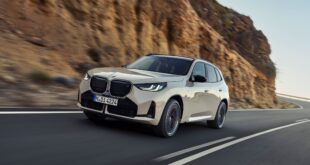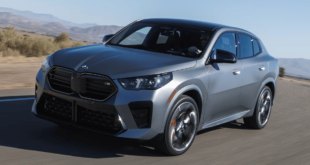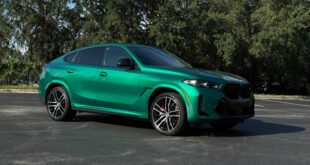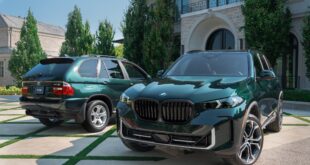Seven years is a pretty long time for a car to be around, but that’s how long BMW’s second generation X3 has been out. While by no means a bad car (the second generation is actually pretty in my opinion), the X3 had always sat in the shadow of the Bavarian marque’s bigger brother even though it practically invented its own segment back in 2003!
Into its third iteration, the X3 has finally grown up and is now more than ready to step out of the X5’s shadows. Thanks to BMW Asia, it was also time for us to board a plane to sunny Australia to be one of the first few people in the region to drive it. Next stop, Cairns!


As you can see, we had quite a welcoming party waiting for us at the airport. On hand were the xDrive30i, the xDrive20d and the xDrive30d. While the diesel powered variants provided some welcomed variety and fun, the only model that’s relevant in our local market is the xDrive30i.

Visually, the new X3 has matured well, now looking bolder and more confident than its predecessor. Gone are the softer curved swage lines from the previous model and in their place, a single broad horizontal line starting behind the front wheel arch towards the rear tail lights.

The wheel arches also now have a pronounced angled cut out, forming a pseudo hexagonal shape. A motif reinforced throughout other areas of the vehicle’s design.
Have a look at the side-blades, the rear quarter glass, the edges of the tail lights and even the rear tail gate shut line. All angled similarly to project a progressive forward motion.


These deliberate and well thought over design elements were introduced to us over dinner by the vehicle’s designer himself, Mr Calvin Luk. The same designer who penned the utterly gorgeous new Z4 Concept.

If you think the new X3 looks smaller than it is, you’re quite right. With the competition hot on its heels, the new X3 had to grow in size. It is now bigger than the original X5!


Sitting on BMW’s CLAR (CLuster ARchitecture) platform, which underpins pretty much every new RWD BMW moving forward, the G01 has gained 54mm on its wheelbase (2,864mm from 2,810mm), 56mm on its overall length (4,708mm from 4,652mm), an extra 7mm on its overall width (1,891mm from 1,884mm) but also, sits lower to the ground with a 37mm reduction off its overall height (1,676mm from 1,713mm). Weight has also been slightly reduced with around 17kg cut from the equivalent model.

This reduction in overall kerb weight and height does not come at the expense of interior comfort. With the new X3 sharing its underpinnings with the 5 Series, the X3 has an airy, spacious and comfortable cabin. With the reduced overall height, interior room also in no way compromised, with plenty of headroom for both front and rear passengers. Those up front will probably have more fun with plenty of toys to keep them busy.


Much of the 5’s tech have made its way into the X3 like the excellent (in my opinion, best of its class) infotainment system equipped with gesture and touch control.
There may be some complaints from those who argue that BMW’s interior lack a revolutionary design “style”, but i’d say, leave the “stylistic” comments to the exterior and focus on “usability” first when it comes to interior layouts.
BMWs have always had first class ergonomics and to forgo functionality to chase an extra bit of form for the interior will be a rather misguided course of action (Hint hint Mercedes…).


Material wise, everything feels great to the touch and build quality is once again excellent with plenty of earlier mentioned design motifs reinforcing the car’s overall design language and attitude.

Out in the back, the flat floor boot has a generous 550 litres of space with the seats upright and expands to a Ikea friendly 1,550 litres with them folded away. Does anyone in Singapore really need that much load space?

Another very thoughtful but rarely (never) seen bit of product design comes when you lift up the (gas-strut supported) rear boot floor, revealing a cut out that allows you to perfectly store the removable cargo cover. Why no one else thought of that before is rather baffling. Expect to see it everywhere else from here on.

Formalities now taken care of, it’s time to take the X3 out on the road.


With a variety of models and road situations planned out for us, we all had a pretty good amount of time behind the wheels of all three variants, sampling each of their drivetrains while taking in some of the local sights.
The cars we drove came equipped with BMW’s Driving Experience Control, toggling the drivetrain and suspension settings to give drivers a choice of how they want their drive. Personally, i like to leave it in “Adaptive” mode and let the car decide. It does a pretty good job.
Around town where most X3s will probably be seen, ride quality is excellent even when running over the occasional bump or rut. There is still an underlying BMW firmness to the ride but it is well dampened. Ensuring a very comfortable trip to the shops.

On some unfamiliar “off road” gravel tracks, the X3 remained reasonably comfortable although plenty of “off road” noise can be heard. When grip became an issue, on-board computers took over to prevent us from running off the road though allowing for a limited amount of initial slip before reeling in the power. We would have loved to push harder for you dear readers, but on unfamiliar loose terrain, it was best to not tempt fate.

As an aside, we did have a rather plucky member of our entourage going full rally-stage and since he came back unscathed, i guess the X3 did pretty good in that respect.

We did give the car a workout on a number of rather exuberant charges up and down mountainous twisties though. With our X3 serving up a healthy chuck of body control. There is some body roll but the car overall remained well planted through most corners. There were times when it did push wide with overly enthusiastic entry speeds but the car remained manageable throughout.
You do feel the higher centre of gravity when connecting a series of bends, but for a car in this market segment, it drives really well. Just don’t try to pretend you’re in a low-slung sports car. Steering might feel a little disconnected at times especially around the center, but loads up decently when going into corners and turn-in feels direct and sharp.
With 350Nm of torque from the xDrive30i, we were delivered us up the summit in extra quick time. For those interested in numbers, 0-100km/h in this 252bhp 2-litre, twin-scroll turbo’ed inline-4 SUV comes in at a very respectable 6.3 seconds.

We tried the the same mountainous roads with the diesel cars and even though they provided plenty of grunt up the hills, ultimately, we felt the petrol version’s more elastic power band and slightly more pleasing vocals gave greater enjoyment.

On the downhill sections, we did feel slightly more skittish with the higher inertia giving the brakes more work to do. This is probably more to do with yours truly trying to avoid a rapid off-the-edge-of-the-road descent than anything to do with the car’s handling. Also, trying to chase an X5M Support vehicle might have something to do with that too. (Those things haul serious a##!)

We cruised on the coastal roads back into town on our return leg and sampled even more local sights as we completed our test of the new X3. It definitely has grown up and is definitely a much more accomplished and all rounded vehicle that can stand proud on its own, right next to its bigger brother.


With the Porsche Macan now muscling into the X3’s market segment, BMW had quite a lot of work to do to elevate their mid-size offering, and that they have done. It’s time to square off against that tarted up Audi.




Thank you once again BMW Asia for the kind invitation, it was a great experience.
 BMW.SG | BMW Singapore Owners Community The Ultimate BMW Community – Established Since 2001
BMW.SG | BMW Singapore Owners Community The Ultimate BMW Community – Established Since 2001













